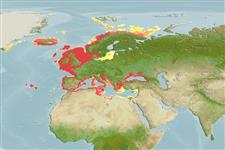Common names from other countries
Environment: milieu / climate zone / depth range / distribution range
Ekologi
; kisaran kedalaman 0 - 250 m (Ref. 78574). Subtropical; 73°N - 21°N, 33°W - 42°E
Northeast Atlantic and the Mediterranean.
Length at first maturity / Size / Weight / umur
Maturity: Lm ? range ? - ? cm Max length : 1.0 cm TL jantan/; (Ref. 78574)
Collected from the sublittoral zone, from low tide up to a depth of 200 m (Ref. 2754). A microalgae herbivore (Ref. 96488). This is an epibenthic species found on reefs (Ref. 95730). It is one of the most abundant microgastropods inhabiting the alga Gelidium latifolium and prefers to live at the base of the plant (Ref. 96520).
Life cycle and mating behavior
Kematangan | Reproduksi, perkembang biakan | Pemijahan | telur-telur | Fecundity | Larva
Members of the order Neotaenioglossa are mostly gonochoric and broadcast spawners. Life cycle: Embryos develop into planktonic trocophore larvae and later into juvenile veligers before becoming fully grown adults.
rujukan utama
Acuan | Koordinator | mitra
Demir, M. 2003. (Ref. 2754)
Status IUCN Red List (Ref. 130435)
status CITES (Ref. 108899)
Not Evaluated
Not Evaluated
penggunaan manusia
| FishSource |
Alat, peralatan
informasi lanjut
Umur / Saiz
Pertumbuhan
panjang-berat
panjang-panjang
Morfologi
Larva
Kelimpahan
Sumber internet
Estimates based on models
Preferred temperature
(Ref.
115969): 6.7 - 15.7, mean 9.8 (based on 632 cells).
keancaman
Low vulnerability (10 of 100).
kategori harga
Unknown.
